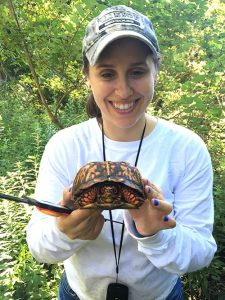Photo above: Algae-scrubber team includes, from left, Christina Giordanella, Elisabeth Van Roijen, Shauna Wright and Associate Professor Kate Aubrecht.
From Stony Brook Students Wield Science on Behalf of Sustainability by Glenn Jochum on SBU Happenings, April 16, 2018
As the nation celebrates another Earth Day and Stony Brook pays homage to the planet with programming aimed at spreading the green gospel to campus and community, Stony Brook students are fanning out with individual and collective projects that make a difference.
Graduate student Lisa Herbert studies trace metals such as iron, manganese, nickel, cobalt and arsenic that are released into the Arctic Ocean by melting glaciers.
Another graduate student, Lisa Prowant is working closer to home by charting the whereabouts of a Long Island inhabitant whose numbers are declining, the Eastern box turtle.
And undergraduate Shauna Wright ’18 is part of a team studying algae for use as a possible biofuel in the Life and Sciences Greenhouse on campus.
Lisa Herbert, who works with Professor Laura Wehrmann, PhD, head of the Biogeochemistry lab in the School of Marine and Atmospheric Sciences, studies fiords in Svalbard, Norway.
“Fiords are the conduits between the glacier and the open ocean,” said Herbert. “Once trace metals enter the fiords in meltwater, they are subject to a number of chemical reactions in the water and sediment that determine whether they crystallize and become trapped in the sediment or dissolve and are transported to the ocean.”
Herbert said that metals have a big impact on marine life because they can act as either fertilizers or toxins and could ultimately affect marine ecology and climate change. Experiments show that fertilizing the ocean with iron (by dumping iron sulfate powder overboard) causes an explosion of algae growth, which in turn stimulates the food chain and sucks carbon dioxide out of the atmosphere.
“I don’t advocate iron fertilization as a means to intentionally remove CO2 from the atmosphere, as some have in the past,” said Herbert. “But I do want to figure out if a natural version of iron fertilization is happening in the ocean as a result of climate change. The poles of our planet are where the effects of climate change occur most rapidly and dramatically, so there is an urgency behind our need to understand what is happening in those places,” she added.
Climate change is also central to Lisa Prowant’s turtle study. New conservation approaches are needed as the climate undergoes change and one such approach is translocation, the human-mediated movement of organisms from one area to another.
“The goal of my research is to create the best translocation plan for the Eastern Box Turtle using information on their predators and Ranavirus, a deadly disease of frogs and turtles.”
While pursuing her master’s degree in biology she learned the threat that climate change is posing on global biodiversity and specifically, on reptiles.
“As of 2013, 19 per cent of reptiles were threatened were extinction. Within that threatened category, established by the International Union for Conservation of Nature, 12 percent as critically endangered, 41 percent as endangered and 47 percent as vulnerable,” Prowant said. Box turtles are one of the vulnerable species and they are right here and once ubiquitous on Long Island.
Via Stony Brook lab connections, Prowant found professors interested in the plight of the box turtle and learned how to radio-track the reptiles. She since turned the project into her dissertation.
After completing two field seasons and collecting information on box turtles and their Long Island predators, Prowant conducted her study at 30 locations from Brooklyn and Queens to Long Island’s Twin Forks. The data collected will help her determine areas that are conducive to translocation.
Shauna Wright has immersed herself in multiple facets of sustainability during her undergraduate career while working toward a bachelor of science in coastal environmental studies and a bachelor of arts in environmental design, policy and planning. Her dedication to the environment extended beyond curricula and classroom, however.
In summer 2016 Shauna served as a land stewardship intern mapping and removing invasive plants from the landscape and lakes of Teatown Lake Reservation in Ossining, New York. In summer 2015, she served as a nature specialist for Yorktown Parks and Recreation in Yorktown, New York. And she has been a member of the Stony Brook University Sierra Club since 2015.
This summer, Shauna will be interning at the International Center for Coral Reef Research and Restoration in the Florida Keys.
In Associate Professor Kate Aubrecht’s Chemistry lab, she became part of a team project that splits its time between the lab and the Life Sciences Greenhouse, exploring conditions that allow for increased lipid production in algae in order to cultivate an efficient biofuel.
“We are using algal turf scrubber units, or water flow devices with tile substrates, built in-house to allow for the cultivation of algae,” she said. “The algae have a variety of potential applications such as medicine, food and fertilizer. Our project seeks to maximize the percent lipid content. We first grow the algae in high nutrient conditions to maximize growth and move it to starvation conditions to promote lipid production.”
By reducing toxins in the oceans, saving turtles and lessening our reliance on fossil fuels, Stony Brook students are using the skills they learned in the field, lab and classroom and saving our planet one project at a time.






